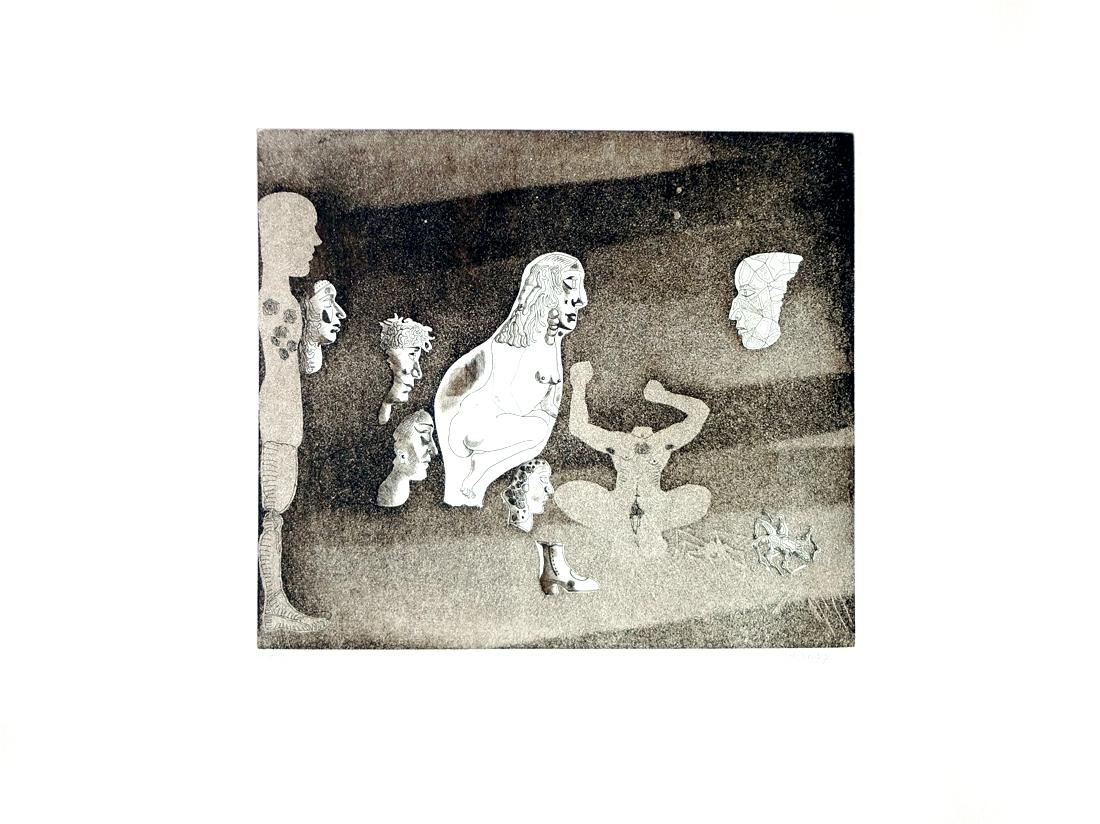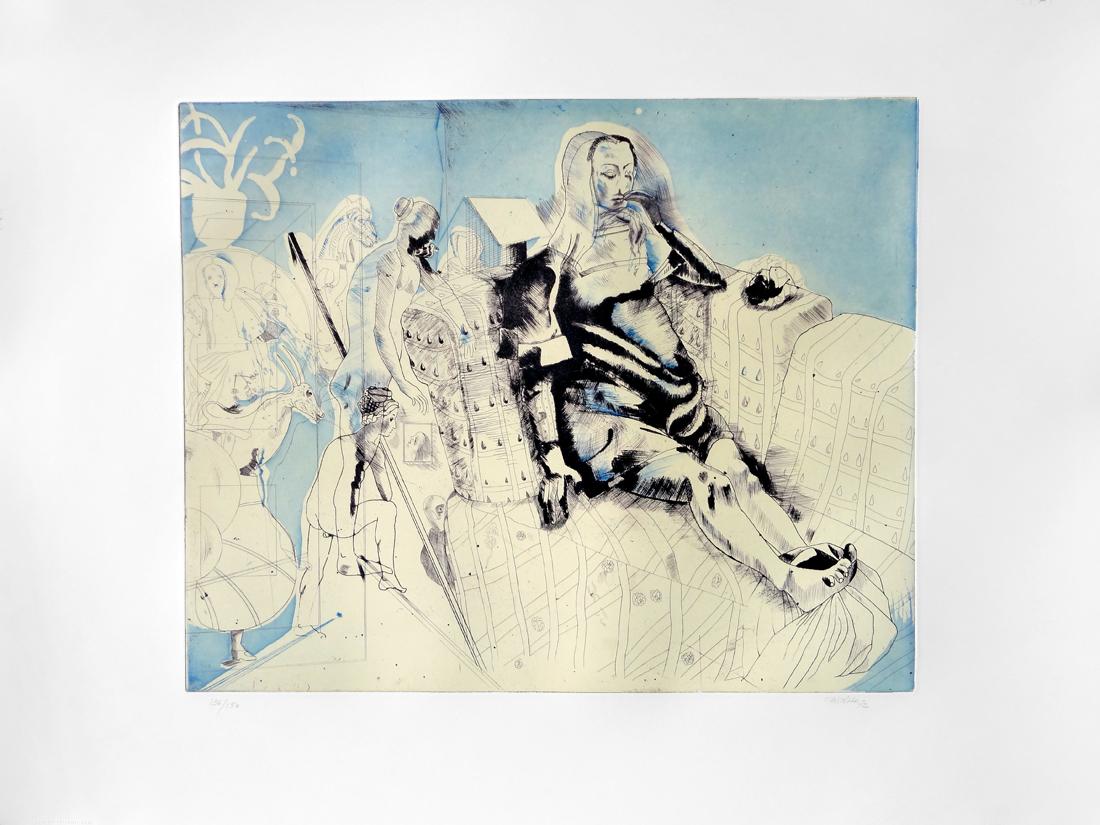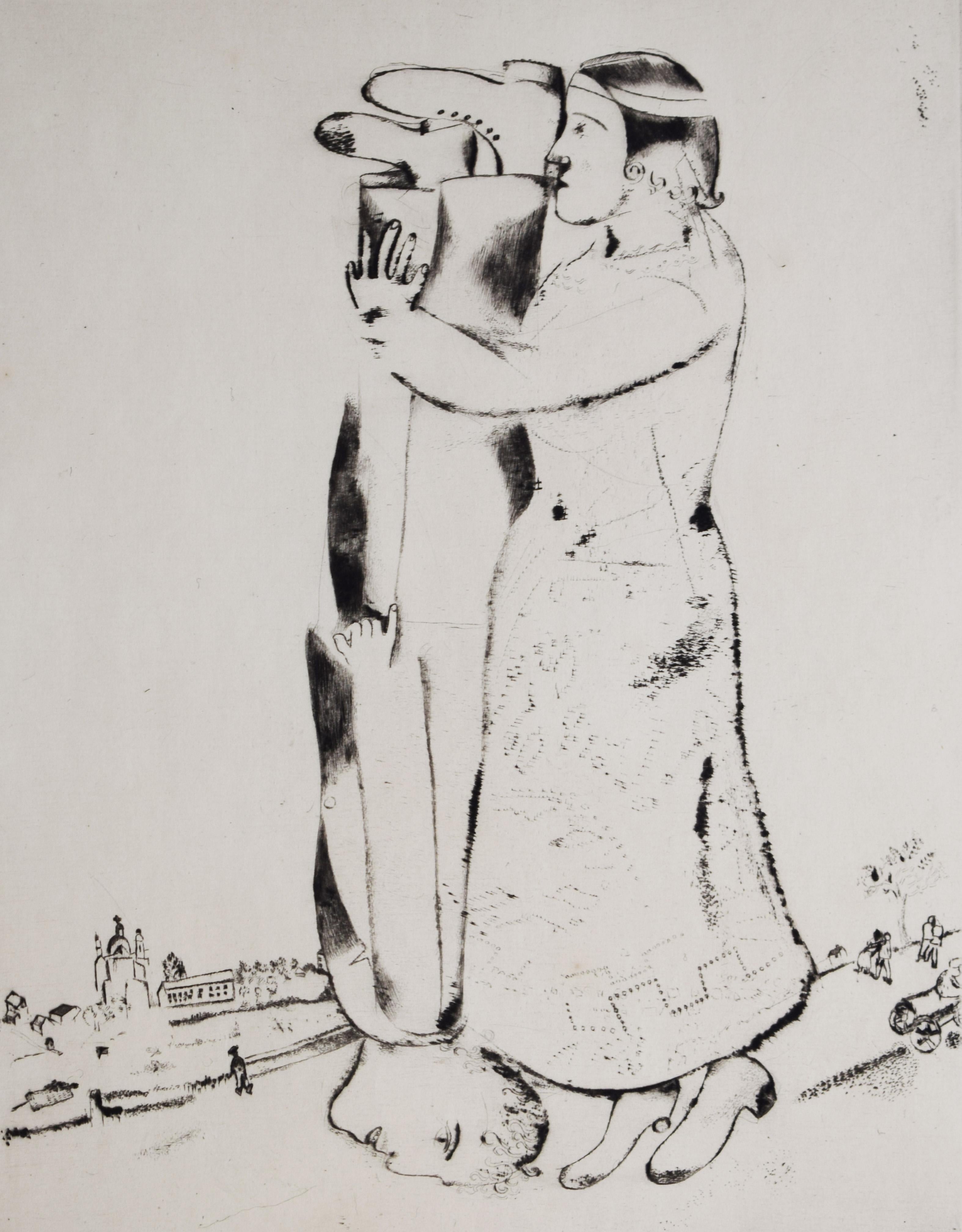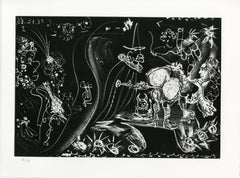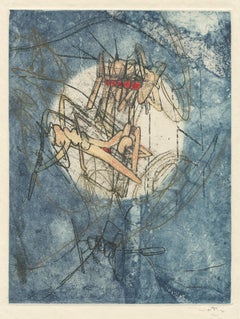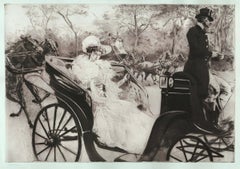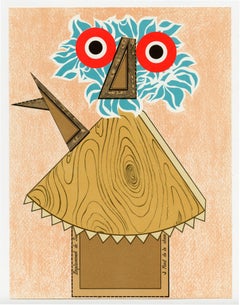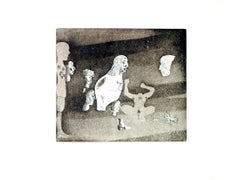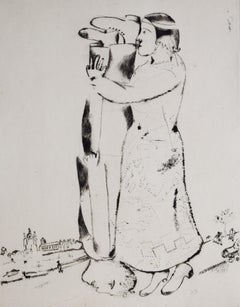Articoli simili a The Web
Vuoi altre immagini o video?
Richiedi altre immagini o video al venditore
1 di 6
Ray H. FrenchThe Web1950
1950
840,82 €
Spedizione
Recupero del preventivo…La promessa 1stDibs:
Garanzia di autenticità,
Garanzia di rimborso,
Annullamento entro 24 ore
Informazioni sull’articolo
The Web
Engraving and soft ground, 1950
Signed, titled, dated and numbered by the artist
Edition: 35 (26/35)
Printed by Master Printer, Jon Clemens, 2000
Provenance:
Estate of the artist
Martha A. French Trust
Note: Shows the artist's psychological struggles from post WWII and life as an artist
Condition: Excellent
Image: 10 3/4 x 7 1/4"
Sheet: 20 x 13 1/4";
Ray H. French: The Evolution of an Artistic Innovator
Printmaker, painter, and sculptor Ray H. French was born in Terre Haute, Indiana on May 16, 1919. Terre Haute was a cultural wasteland before the opening of the Sheldon Swope Art Museum in 1942. Thus, with a father as a coal miner and carpenter, art remained a luxury for Ray. Nevertheless, local art teachers Mabel Mikel Williams and Nola E. Williams helped to foster his creativity and unshakable drive to create things of beauty.
After high school, Ray attended the John Herron School of Art in Indianapolis. His studies there were interrupted by the outbreak of World War II, during which he developed surveillance photographs for the Army Air Force. After the war, Ray transferred to the University of Iowa on the G.I. Bill, where he received both his BFA and MFA degrees. The University of Iowa during the 1940s was a cultural mecca with many major art historians and artists. While in Iowa, Ray played an important role in this culture by becoming a founding member of the Iowa Print Group under Mauricio Lasansky.
Following his graduation in 1948, Ray experienced firsthand the rapid rise in creative printmaking in America. By 1949, he had exhibited at The Brooklyn Museum, the Walker Art Center, and MOMA New York. Ray’s early style of printmaking is characterized by pure line engraving on copper plates, a technique suited perfectly to his study of the beauty of animals. This charming and whimsical subject ran counter to the concurrent trends of Lasansky’s horrors of war and Hayter’s non-objectivity, but was equally effective in capturing the public’s attention. Walruses was purchased by the Victoria and Albert Museum, exhibited at MOMA New York and received the Arthur D. Allen Memorial Purchase Prize for its “skillful and economic use of line.” Shortly thereafter, Ray’s treatment of animals developed further into larger format mixed intaglio prints utilizing hard ground, soft ground, etching, and engraving, as exemplified in The Swan.
By the late 1950s, Ray’s style evolved into organic non-objectivity, in which he incorporated personal autobiographical vignettes and symbolism. His work during this time was further characterized by a departure from the traditional squared compositional format to his cutting and rounding of the plate to accentuate organic shapes. Ray’s 1959 Enchantment remains particularly illustrative of his use of etching and soft ground intaglio. Enchantment was successfully exhibited at the Brooklyn Museum of Art for the 12th National Print Exhibition of The American Federation of the Arts and received the Pennell Purchase Prize from the Library of Congress in 1960.
In the 1960s, Ray also started to focus on blind embossing, which he had first experimented with at the University of Iowa. He was extremely prolific and successful with this medium, selling hundreds of prints in small editions of 10 through the Associated American Artist Gallery in New York. In 1966, Ray built upon his mastery of embossing and began developing a shadow box presentation called a graphic construction that combined color, blind embossing, and multi-layered cutouts to revel intaglio compositions. Noted curator William Lieberman purchased Ray’s masterpiece graphic construction, Moon Rays, on the behalf of MOMA New York and another impression was gifted to the University of Iowa Museum of Art by Alan and Ann January in 2004.
Throughout his artistic career, Ray was also a professor and administrator at DePauw University, which occupied much of his time. Outside of his creative expression, Ray was most proud of his teaching and influencing students to find beauty in their daily lives. Specifically, he was a particularly fervent advocate of printmaking and joined the ranks of many of Lasansky’s students who went on to establish printmaking programs and departments and to further lift the stature of intaglio printmaking. During Ray’s time at DePauw, he received grants to travel around Europe. His yearlong stay in Florence led to a series of etchings, drypoints, and woodcuts of Italian and Etruscan subjects and provided inspiration for many years.
In 1984, Ray retired from his university service to work in a private studio behind his home on DePauw’s campus. After several life threatening illnesses, Ray decided to return to his early creative style of realist depictions of nature and landscape. Eventually, Ray’s health deteriorated further with the onset of macular degeneration. Legally blind, he continued to create art until shortly before his death in 2000 at the age of 80. “Sometimes when I look at a work I create, I am amazed at what inspired it. I ask myself, how on earth did I create this?” said Ray once. Ultimately, this quest to find beauty and create inspiring works of art provided the greatest source of Ray’s happiness and fulfillment, evidenced by the breadth and quality of his artistic legacy.
- Creatore:Ray H. French (1919-2000, Americano)
- Anno di creazione:1950
- Dimensioni:Altezza: 27,31 cm (10,75 in)Larghezza: 18,42 cm (7,25 in)
- Tecnica:
- Movimento e stile:
- Periodo:
- Condizioni:
- Località della galleria:Fairlawn, OH
- Numero di riferimento:Venditore: RHF00161stDibs: LU14016519512
Informazioni sul venditore
5,0
Venditore riconosciuto
Questi venditori prestigiosi sono leader del settore e rappresentano il massimo in termini di qualità e design.
Venditore Oro
Venditori Premium con valutazione 4,3+ e tempi di risposta entro 24 ore
Fondazione nel 1978
Venditore 1stDibs dal 2013
793 vendite su 1stDibs
Tempo di risposta standard: <1 ora
Associazioni
International Fine Print Dealers Association
- SpedizioneRecupero del preventivo…Spedizione da: Fairlawn, OH
- Politica di reso
Alcune parti di questa pagina sono state tradotte automaticamente. 1stDibs non può garantire che le traduzioni siano corrette. L’inglese è la lingua predefinita del sito.
Garanzia di autenticità
Nell’improbabile caso in cui si verifichi un problema con l’autenticità di un articolo, contattaci entro un anno per ottenere un rimborso completo. DettagliGaranzia di rimborso
Se il tuo articolo non corrisponde alla descrizione, è danneggiato durante il trasporto o non arriva, contattaci entro 7 giorni per un rimborso completo. DettagliAnnullamento entro 24 ore
Hai un periodo di tolleranza di 24 ore per annullare il tuo acquisto, senza necessità di fornire spiegazioni.Venditori professionali selezionati
I nostri venditori di livello internazionale devono aderire a rigorosi standard di servizio e qualità, garantendo l’integrità delle inserzioni.Garanzia miglior prezzo
Se scopri che un venditore ha pubblicato altrove lo stesso articolo a un prezzo più basso, applicheremo lo stesso prezzo.Consegna globale affidabile
La nostra rete di vettori leader del settore offre opzioni di spedizione specializzate in tutto il mondo, inclusa la consegna personalizzata.Altro da questo venditore
Mostra tuttoPiatto VI, Le Cocu Magnifique
Di Pablo Picasso
Piatto VI, Le Cocu Magnifique
acquaforte e acquatinta, 1968
Senza segno come al solito
Dall'edizione non firmata di 200 copie stampate su carta Rives BFK.
Esiste anche un'edizione fi...
Categoria
Anni 1960, Surrealismo, Stampe figurative
Materiali
Acquaforte, Acquatinta
De trace de pas de trace de...
Di Roberto Matta
De trace de pas de trace de...
Acquaforte a colori con acquatinta, 1966
Da: Monsour e Matta, Les Damnations, 1966 (11 tavole, questa di 7 immagini fuori testo)
Edizione: 85 portfolio...
Categoria
Anni 1960, Surrealismo, Stampe astratte
Materiali
Acquaforte, Acquatinta
La Promenade
Di Edgar Chahine
La Promenade
Etching, soft-ground, aquatint & drypoint,
Signed in pencil lower left
Published by Edmund Sagot, Paris
Edition of 50 in black only, aside from the edition of 50 in co...
Categoria
Inizio Novecento, Art Nouveau, Stampe figurative
Materiali
Puntasecca, Acquaforte, Acquatinta
XXe Siecle (Occhi Rossi)
Di Enrico Baj
Non firmato, come di consueto per questa pubblicazione
Da: XXe Siecle, Volume 44, 1975
Pubblicato da G. di San Lazzaro per A. Maeght, Parigi
Stampato da Mourlot, Paris
Edizione 3...
Categoria
Anni 1970, Surrealismo, Stampe figurative
Materiali
Litografia
Testa di donna (Vrouwekop), Marguerite Adolphine Helfrich
Di Jan Toorop
Testa di donna (Vrouwekop), Marguerite Adolphine Helfrich
Puntasecca, 1897
Firmato in basso a destra a matita: J Toorop; di mano successiva
La modella di Toorop per questa stampa è ...
Categoria
Anni 1890, Jugendstil, Stampe figurative
Materiali
Puntasecca
Dario a 10 anni
Di Darius Steward
Dario a 10 anni
Puntasecca, 2022
Firmato, intitolato e numerato a matita
Stampato da Rebekah Wilhelm
Il suo timbro a secco in basso a destra
Pubblicato dall'artista
Edizione 14, più ...
Categoria
Anni 2010, Realismo americano, Stampe figurative
Materiali
Puntasecca
Ti potrebbe interessare anche
Jorge Castillo - COMPOSIZIONE EROTICA Acquaforte su carta Surrealismo spagnolo
Di Jorge Castillo
Jorge Castillo - COMPOSICIÓN ERÓTICA (Composizione erotica)
Data di creazione: 1977
Mezzo: Acquaforte su carta
Edizione: 75 + 20 E.A.
Dimensioni: 50 x 65,5 cm
Condizioni: In perfette...
Categoria
Anni 1970, Surrealismo, Stampe figurative
Materiali
Incisione, Acquaforte
Jorge Castillo - MARIENZA EN DOMINGO Acquaforte Surrealismo Spagnolo Femminile
Di Jorge Castillo
Jorge Castillo - MARIENZA EN DOMINGO
Data di creazione: 1972
Mezzo: Acquaforte su carta
Edizione: 150 + H. A. C.
Dimensioni: 56 x 70 cm
Condizioni: In perfette condizioni e mai incor...
Categoria
Anni 1970, Surrealismo, Stampe figurative
Materiali
Carta, Incisione, Acquaforte
Gli amanti da: La mia vita Die Liebenden: Mein Leben - Russo Francese Berlino
Di Marc Chagall
Questa acquaforte originale con puntasecca è firmata a mano a matita dall'artista "Marc Chagall" nel margine inferiore destro.
È inoltre numerata a mano a matita dall'edizione di 11...
Categoria
Anni 1920, Surrealismo, Stampe figurative
Materiali
Puntasecca, Acquaforte
"Senza titolo"
Di Nahum Tschacbasov
Incisione originale, acquatinta, calcografia su carta d'archivio. Firmato e datato in basso a destra, 1947. Prova d'artista. Condizioni: Buono. Provenienza: Proprietà dell'artista....
Categoria
Anni 1940, Surrealismo, Stampe figurative
Materiali
Carta per archivio, Incisione, Acquatinta, Intaglio
389 € Prezzo promozionale
20% in meno
"Senza titolo"
Di Nahum Tschacbasov
Incisione originale, acquatinta e calcografia su carta d'archivio dell'artista russo/americano Nahum Tschacbasov. Firmato a matita in basso a destra e datato 1947. Condizioni: buone...
Categoria
Anni 1940, Surrealismo, Stampe figurative
Materiali
Carta per archivio, Incisione, Acquatinta, Intaglio
371 € Prezzo promozionale
20% in meno
"Senza titolo"
Di Nahum Tschacbasov
Prova d'artista, acquatinta, incisione mista calcografica dell'artista russo/americano Nahum Tschacbasov. Firmato a matita e datato in basso a destra, 1947. Prova d'artista. Condiz...
Categoria
Anni 1940, Surrealismo, Stampe figurative
Materiali
Incisione, Acquatinta, Intaglio
371 € Prezzo promozionale
20% in meno
